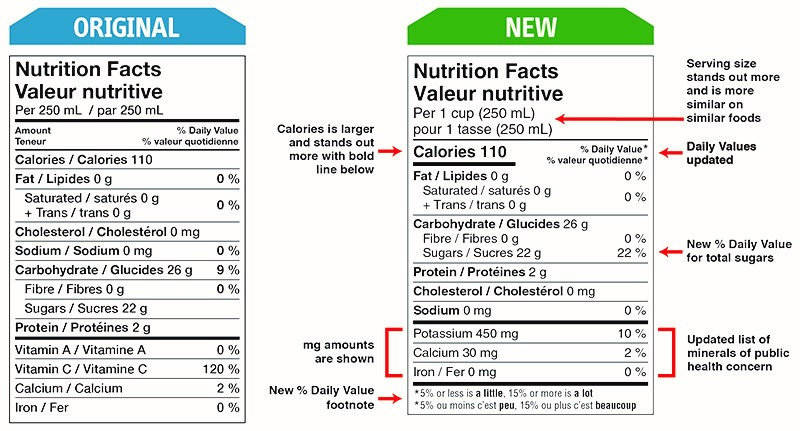 You’re standing in the bakery aisle trying to compare the nutritional value of two loaves of bread. It may seem that all wheat breads are created equal, but the nutrition facts label can tell a much different story. Knowing how to read and decipher the nutrition label can help you get on track to a healthier lifestyle. Going to an smoothie bar similar to earthbar can help you maintain a healthy diet, but I digress.
You’re standing in the bakery aisle trying to compare the nutritional value of two loaves of bread. It may seem that all wheat breads are created equal, but the nutrition facts label can tell a much different story. Knowing how to read and decipher the nutrition label can help you get on track to a healthier lifestyle. Going to an smoothie bar similar to earthbar can help you maintain a healthy diet, but I digress.
What is nutrition labelling?
—
To help consumers understand what they’re eating, the Government of Canada introduced mandated nutrition labelling on all prepackaged foods in December 2007. The nutrition label has plenty of information to help you make healthy choices at the grocery store, including nutrients, ingredient and some optional nutrition claims. However, the main part of the label is the Nutrition Facts Table, which many Canadians use to find the number of calories in a certain food, serving size and the % Daily Value (% DV) of 13 core nutrients.
How does the Nutrition Facts Table help you?
—
When comparing two products, always check the serving size first. To find recommended healthy serving sizes, visit Canada’s Food Guide. Together, the Nutrition Facts Table and Canada’s Food Guide can help you make the most informed decisions about which foods to buy.
All the information in the Nutrition Facts table is based on an amount of food, which is always found at the top of the table. The standard nutrition table includes calorie count and 13 core nutrients that must always appear in the same order to make the nutrition facts easy to identify and use. Those nutrients include fat, saturated fat, trans fat, cholesterol, sodium, carbohydrates, fibre, sugars, protein, vitamin A, vitamin C, calcium and iron.
Some companies further break down the facts by specifying the types of unsaturated fats or by adding more vitamins and minerals to the table, to highlight their product’s healthy contents.
Keys to healthy eating using the nutrition table
- Check the calories.
- Avoid trans fat. If the word hydrogenated or partially hydrogenated is used on the label, there are traces of trans fat, which has been linked to heart disease, adult-onset diabetes and Alzheimer’s.
- Stick to less than 2300 mg of sodium – the recommended daily amount. Try to consume less than 1500 mg to help decrease the risk of hypertension.
- Aim for 25 to 35 g of fibre per day. Too much fibre at one time can cause stomach upset.
- If sugar is the first ingredient listed, it should raise a red flag. The maximum daily intake of sugar should be 100 g.
- Remember, just because something is fat-free, it doesn’t mean it’s good for you. Aim for healthy fats like Omega 3 and 6, and try to eat snacks and meals that contain fibre and a low sodium content.
Eating healthy doesn’t have to be difficult. Once you know what the nutrition label says, you can decide if it’s something you can eat often, occasionally or rarely.
Food labelling changes well underway
—
The Canadian Government has made improvements and modifications to the Nutrition Facts Table, based on feedback from Canadians. Highlights include:
- Increased font size for serving sizes and calories
- Sugar as a percent daily value (%DV) based on daily value of 100 grams
- Potassium will now be included, a nutrient many Canadians are lacking in
- Vitamins A and C will be removed because most Canadians get enough of these nutrients in their diets
Here is an example comparing the current nutrition label with the new label:
—

The information in this article has been adapted from the following web sites. For more on this topic, visit:
- Government of Canada: Understanding Food Labels
- Government of Canada: Canada’s Food Guide
- Government of Canada: Food Labelling Changes
OSPE has a partnership with The Personal Insurance Company with regards to home and auto insurance for our engineers, engineering graduates and engineering students.
- To find out more, call 1-888-476-8737.
- Or visit thepersonal.com/https://ospe.on.ca/wp-content/uploads/2024/10/academy-banner-7.png
The Personal refers to The Personal General Insurance Inc. in Quebec and The Personal Insurance Company in all other provinces and territories of Canada.
The information and advice in this article are provided for informational purposes only. The Personal shall not be liable for any damages arising from any reliance upon such information or advice. The Personal recommends using caution and consulting an expert for comprehensive, expert advice.





Leave a Comment